
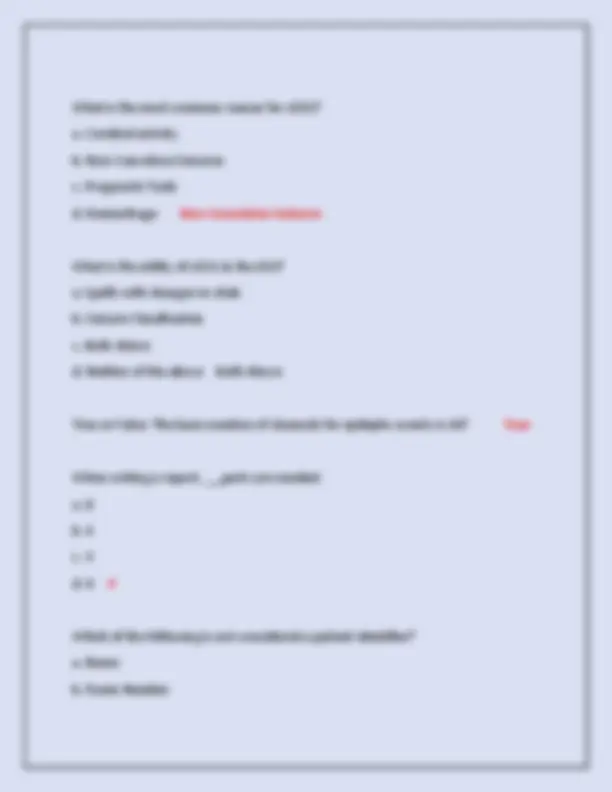
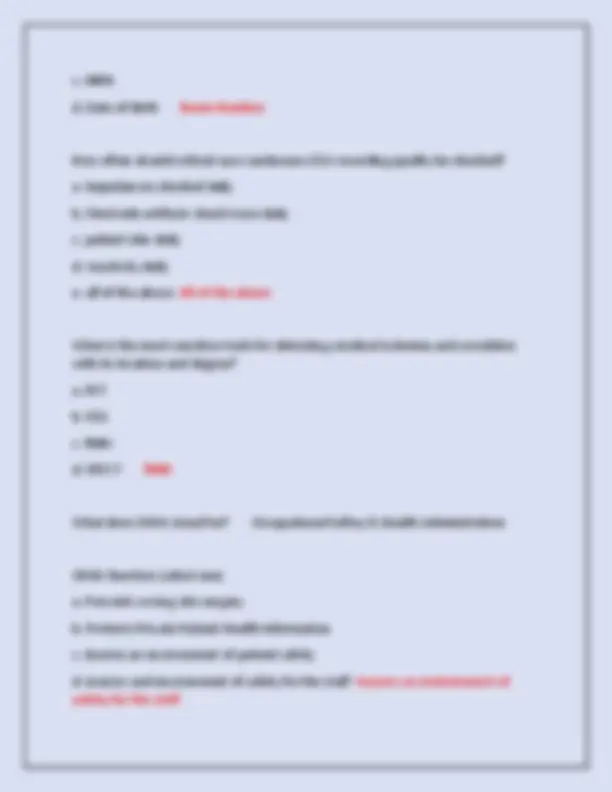
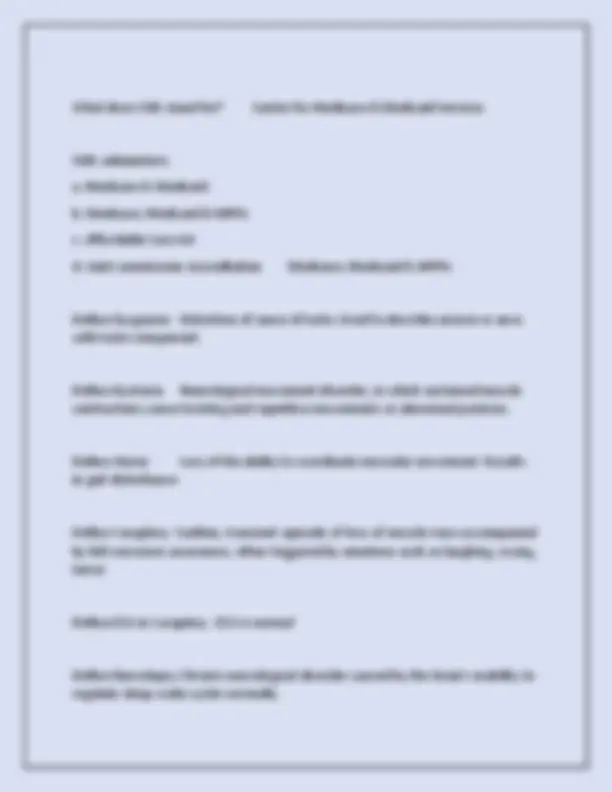
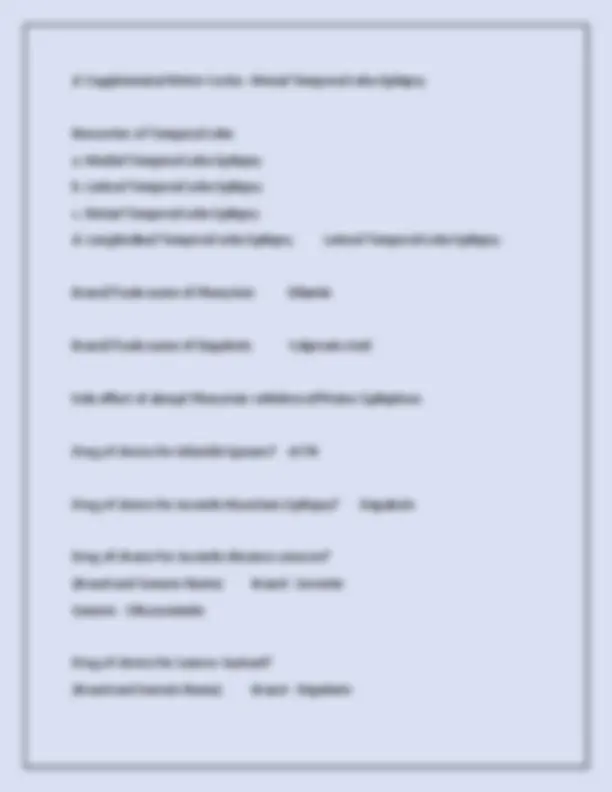
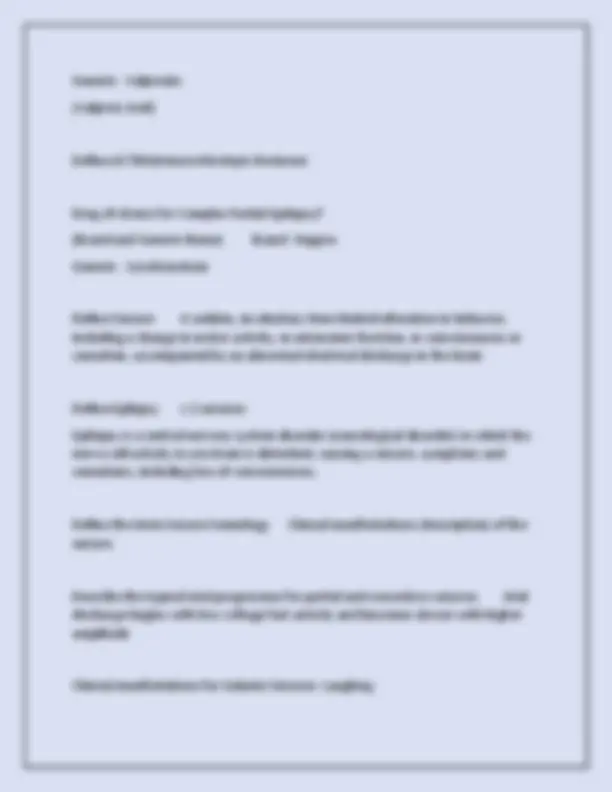
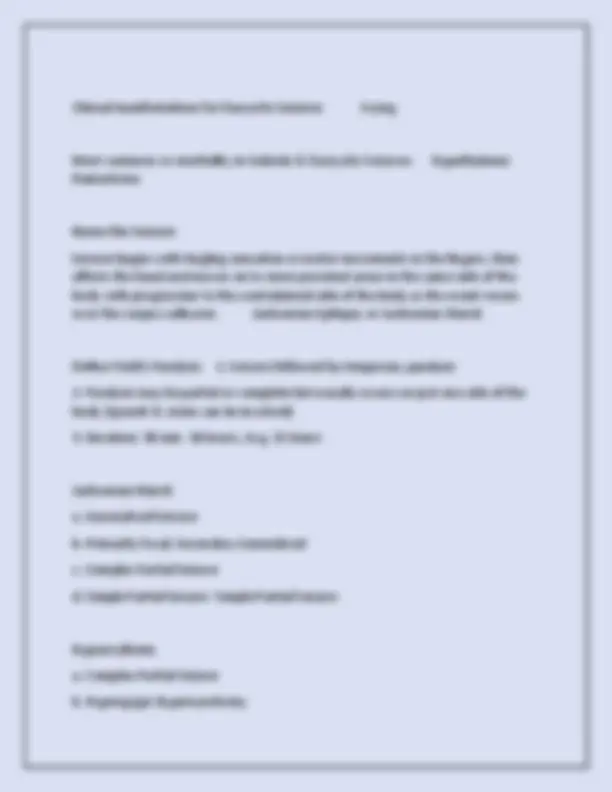
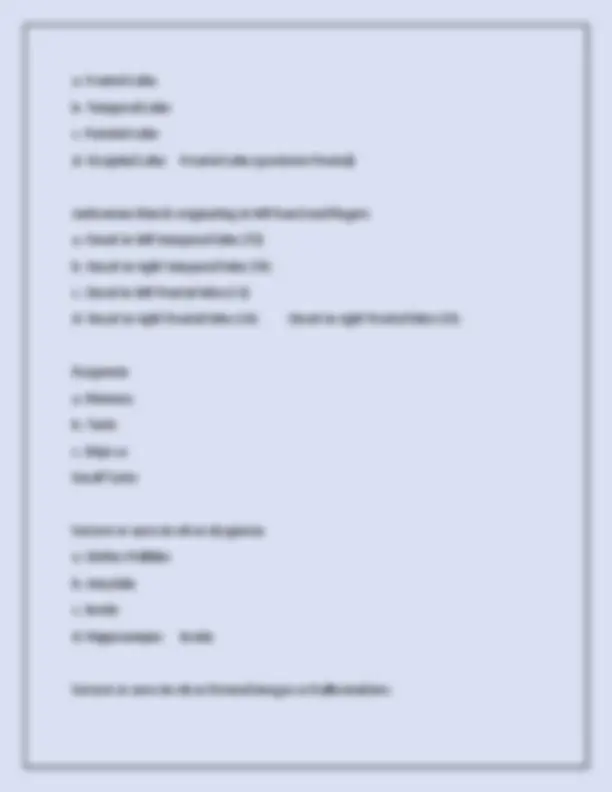
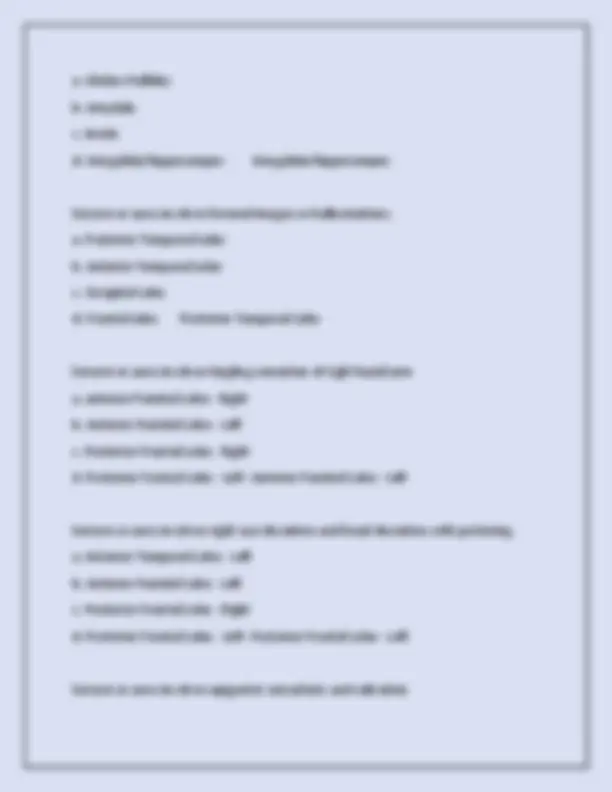
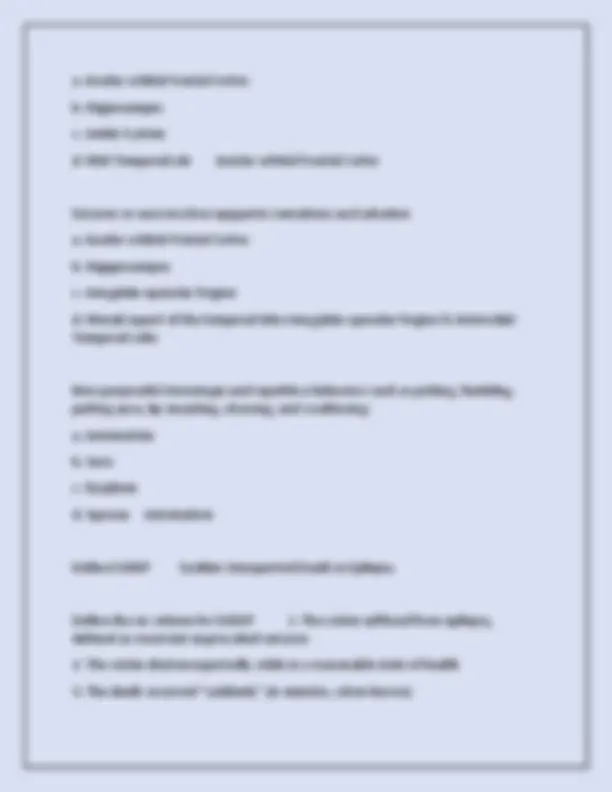
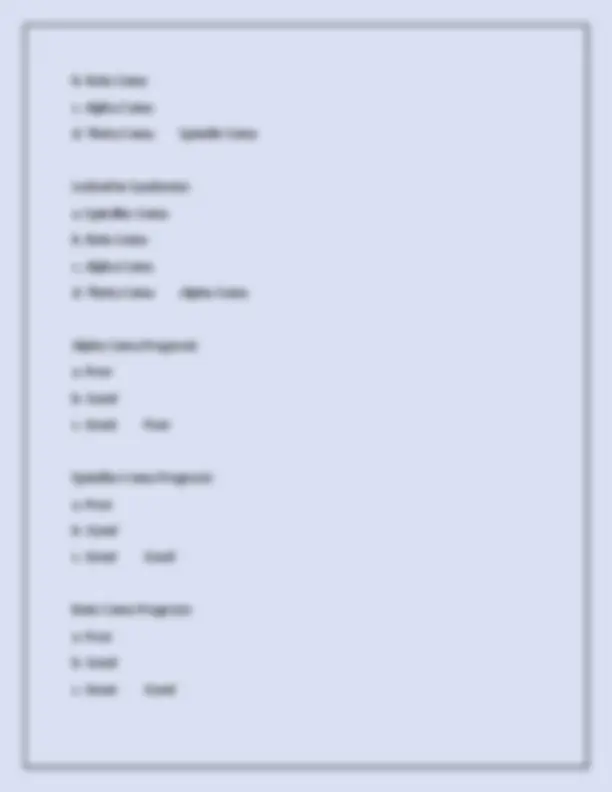
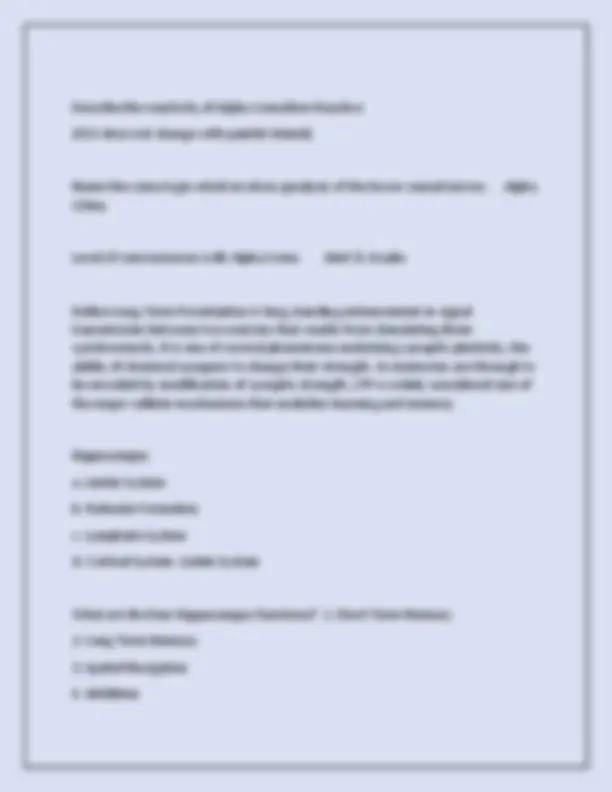
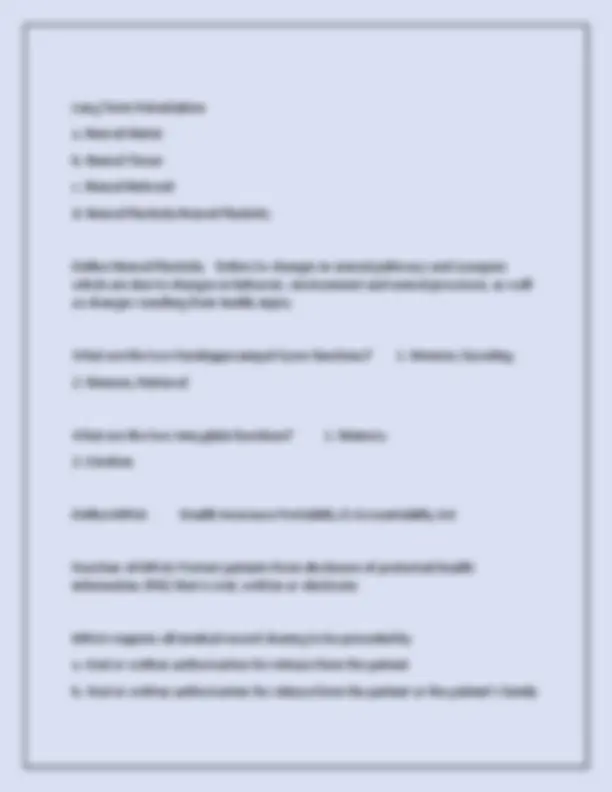
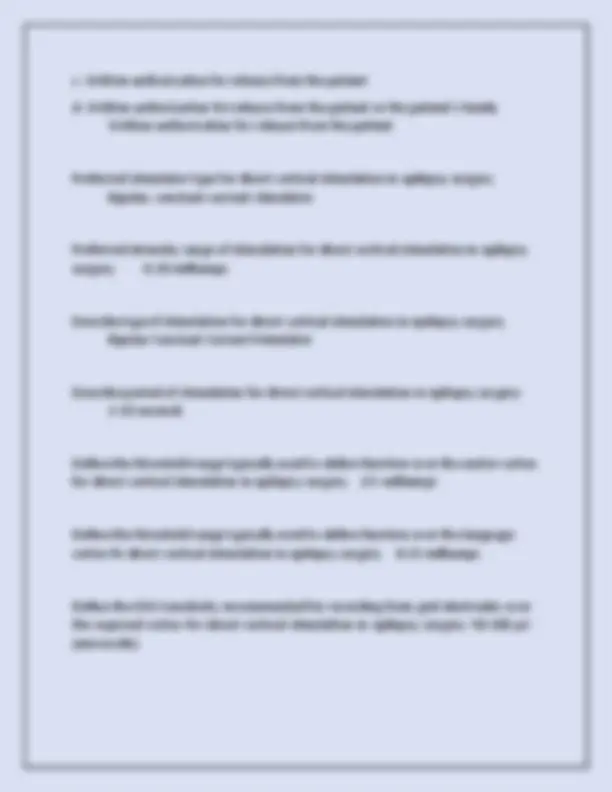
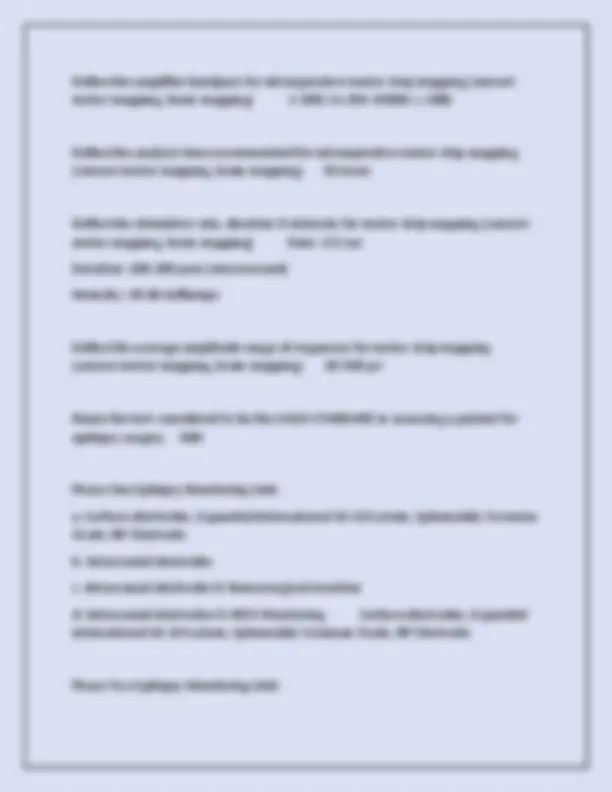
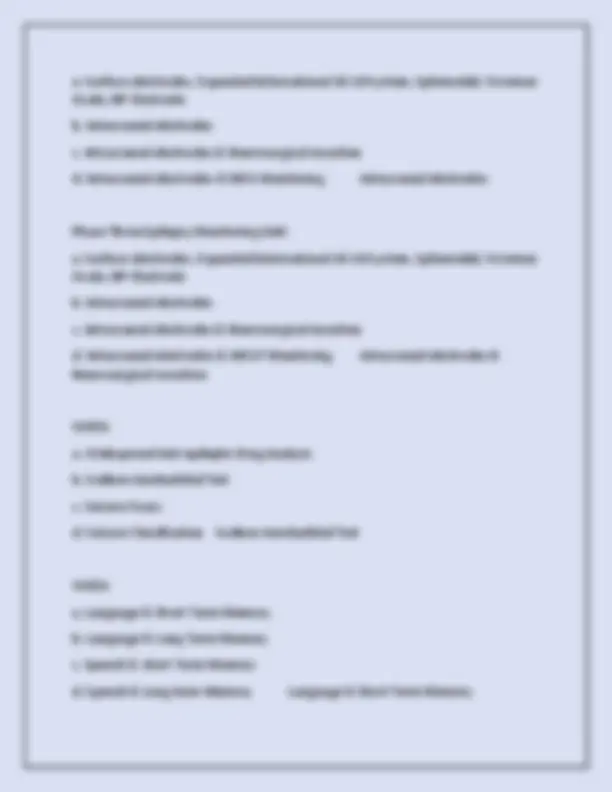
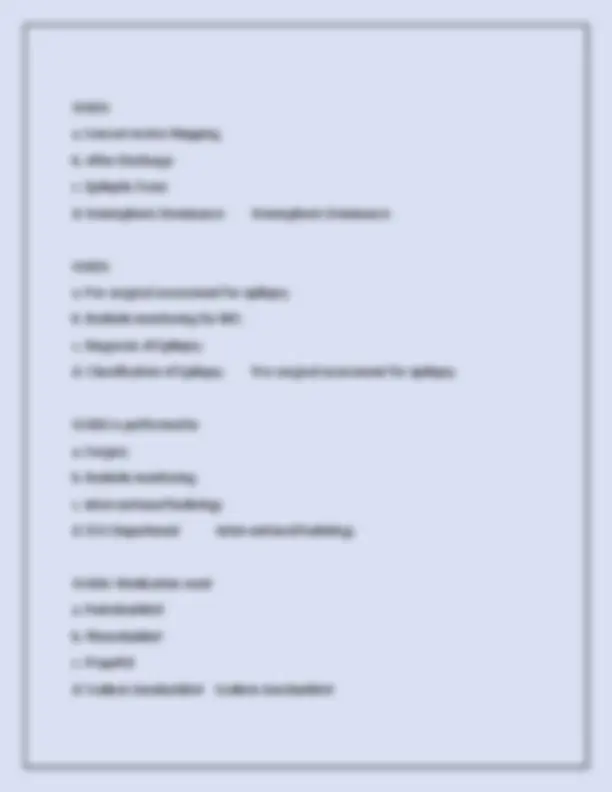
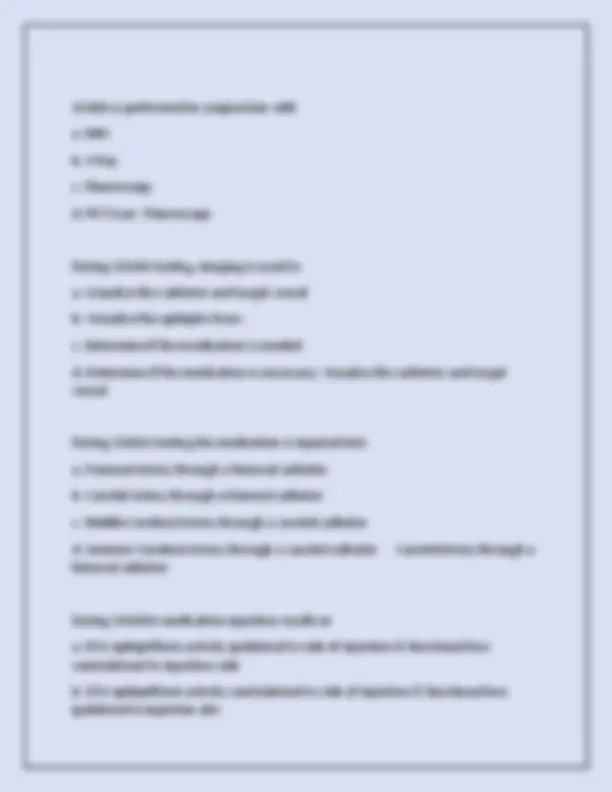

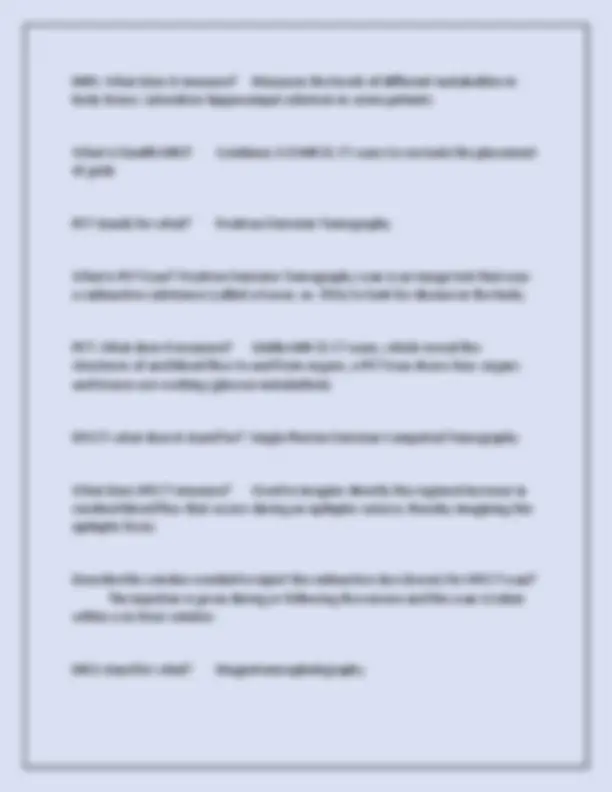
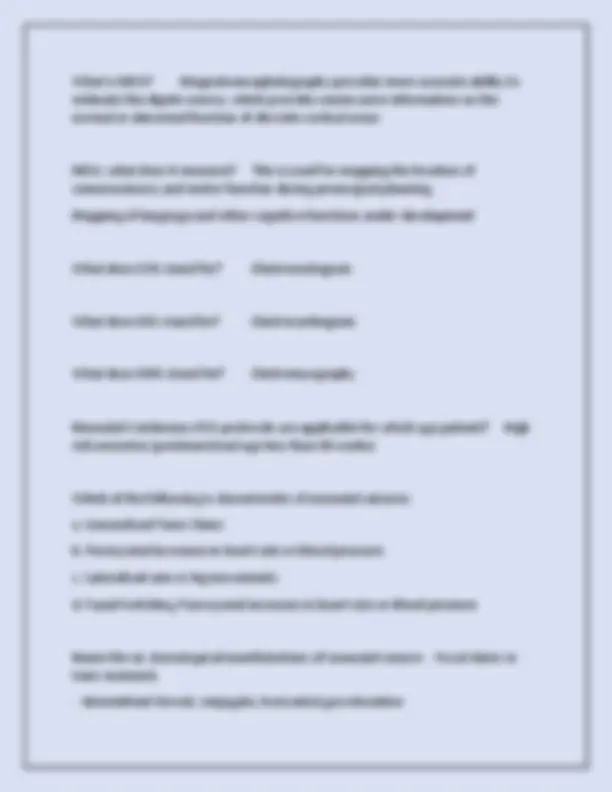
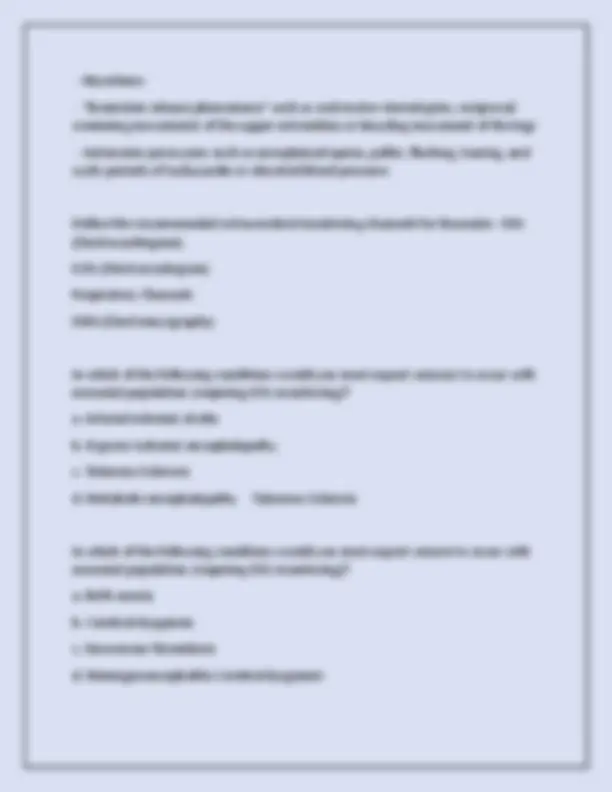
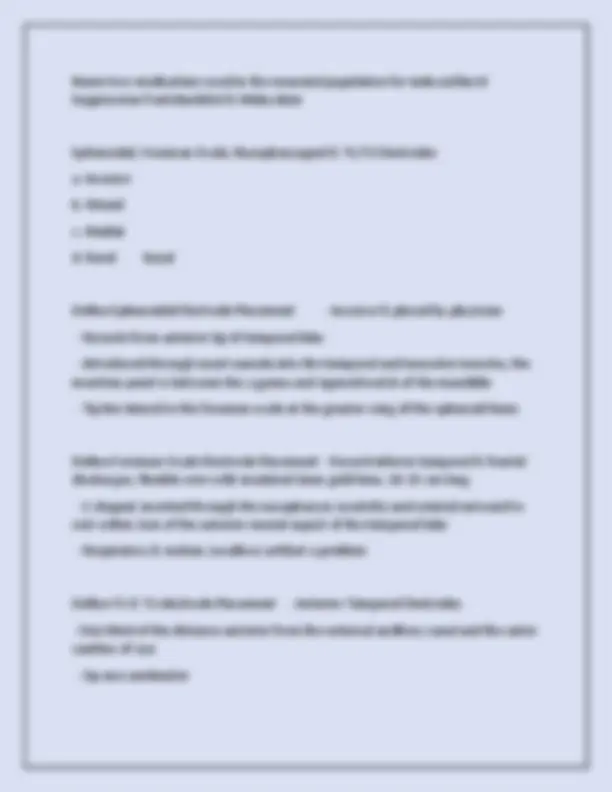
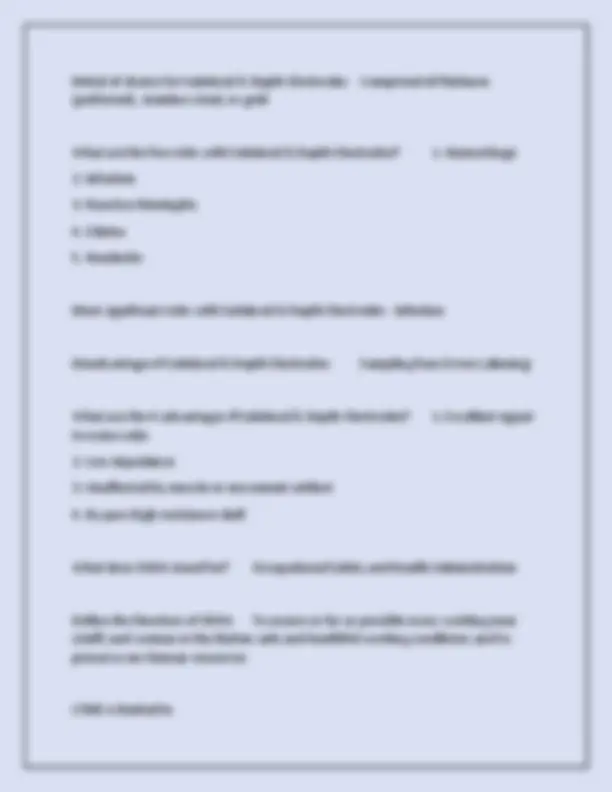
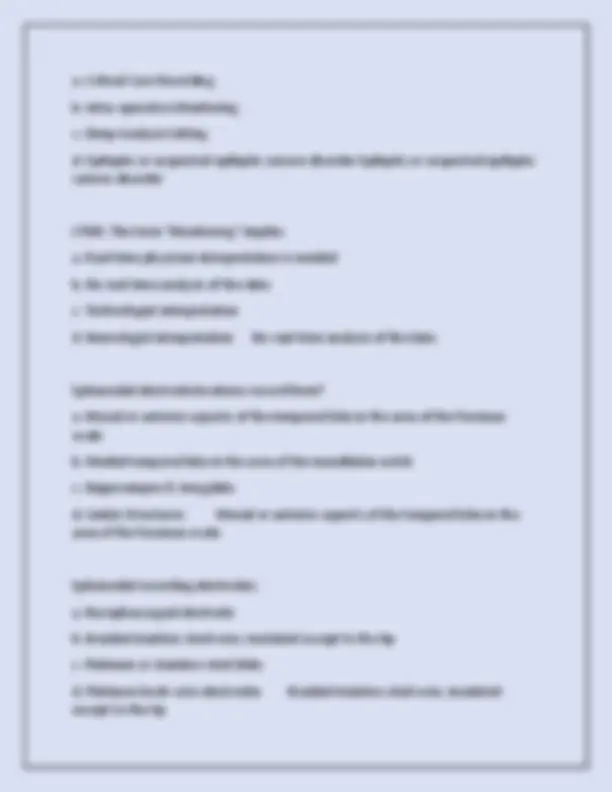
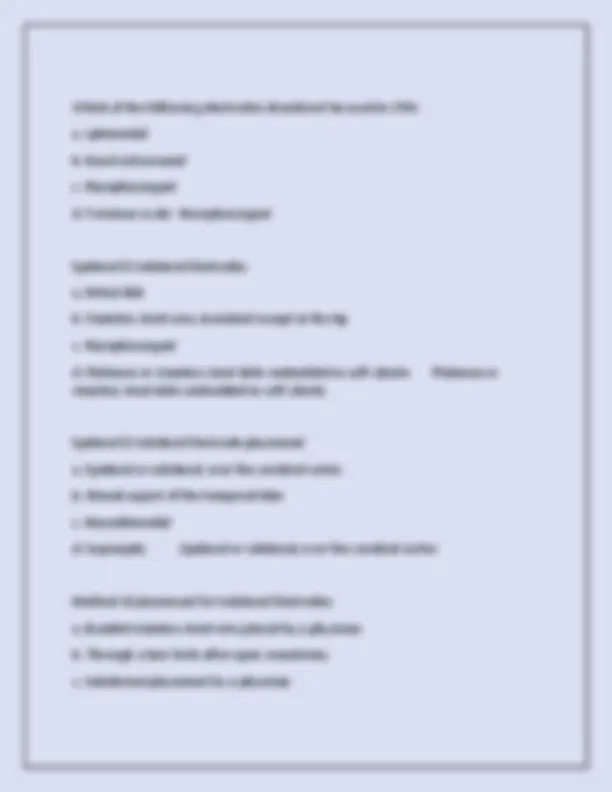

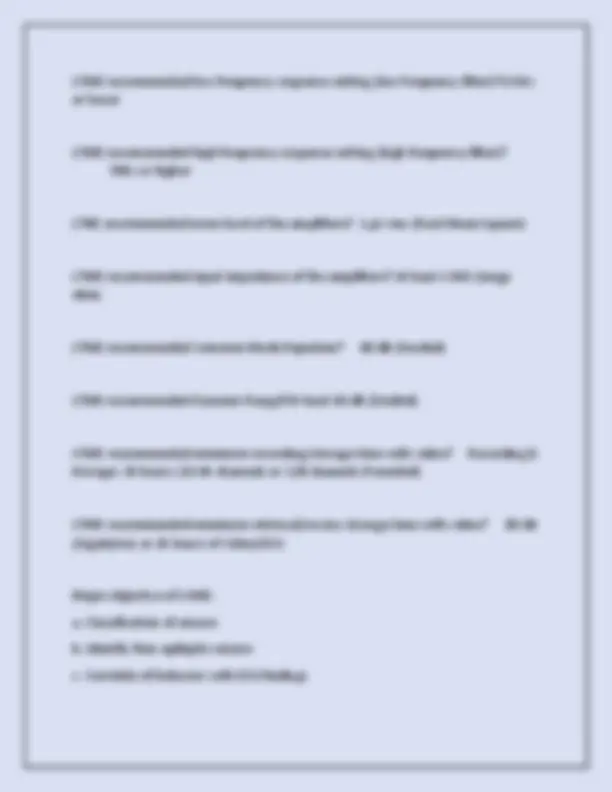
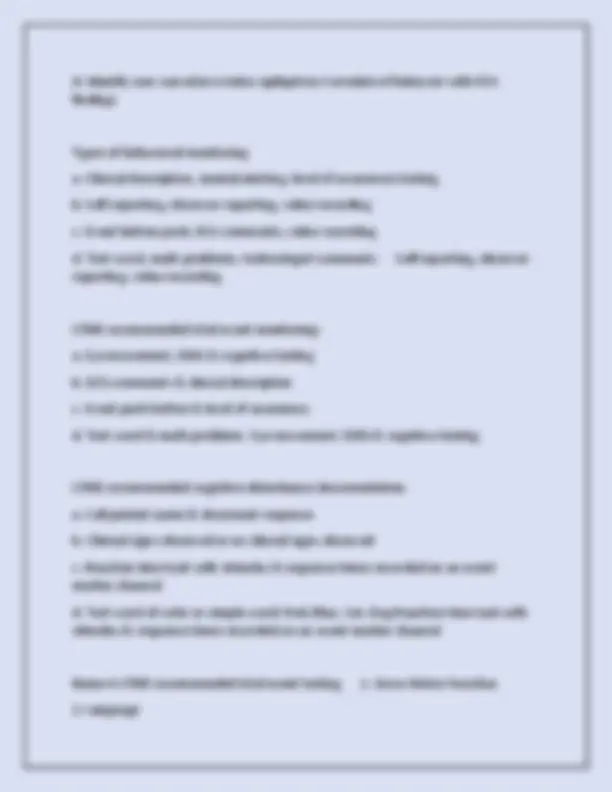
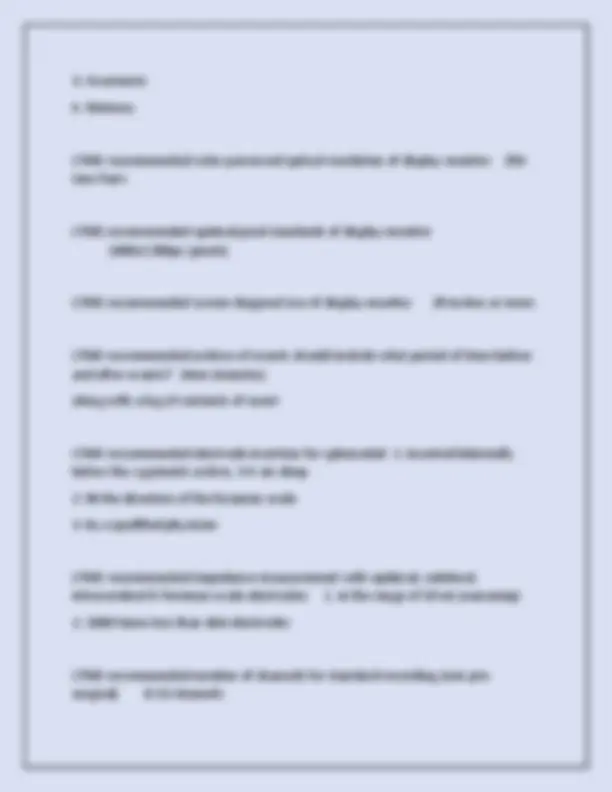
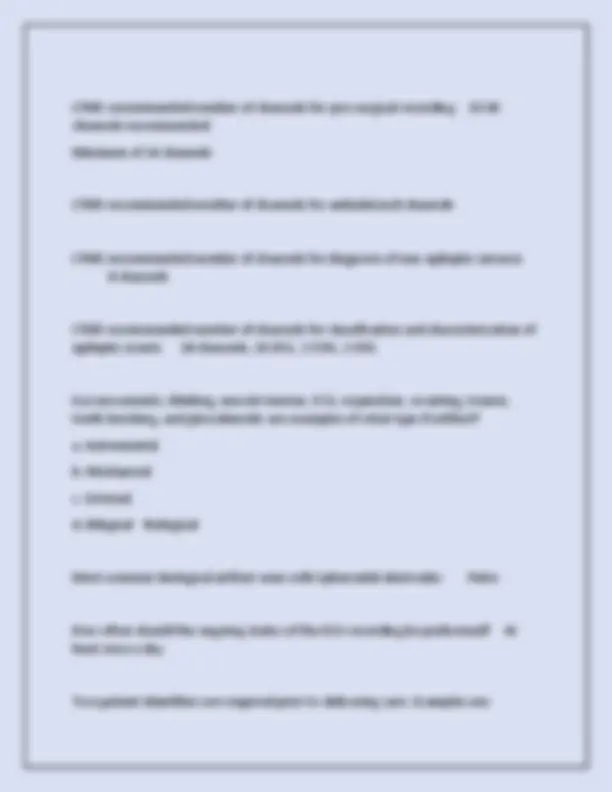
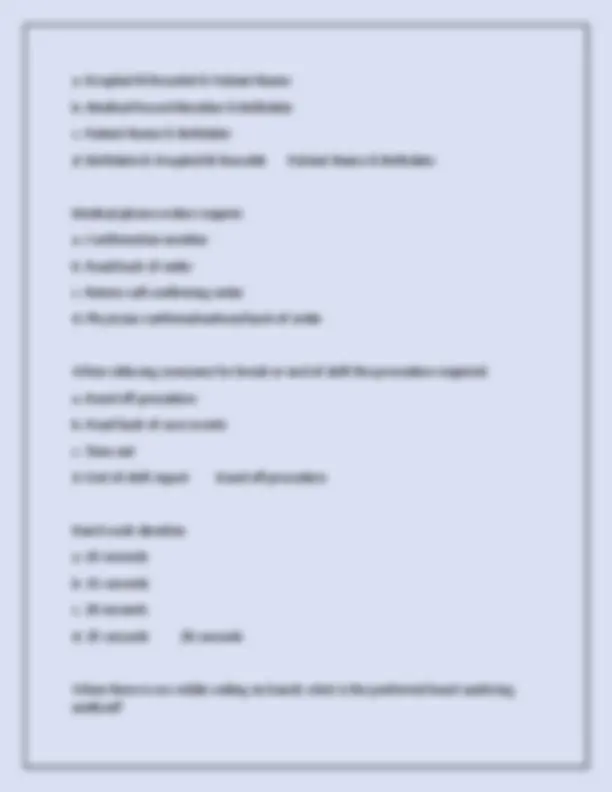
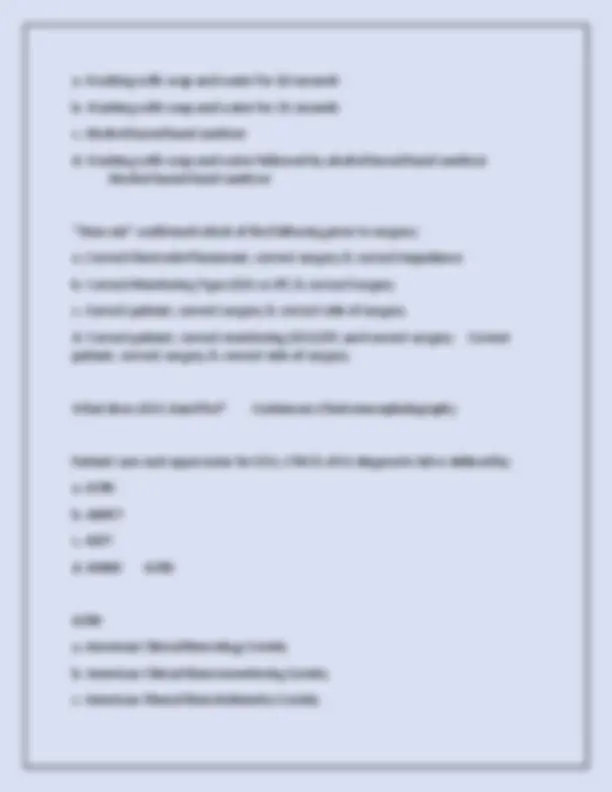
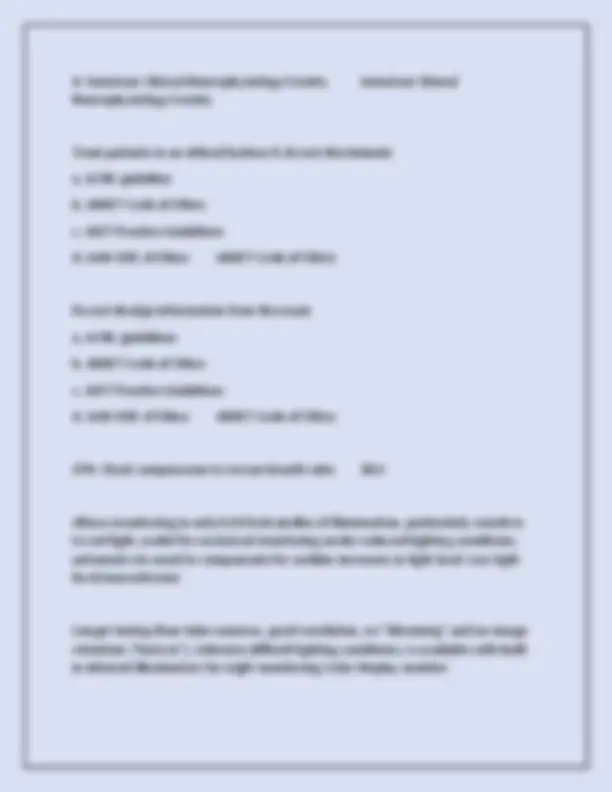
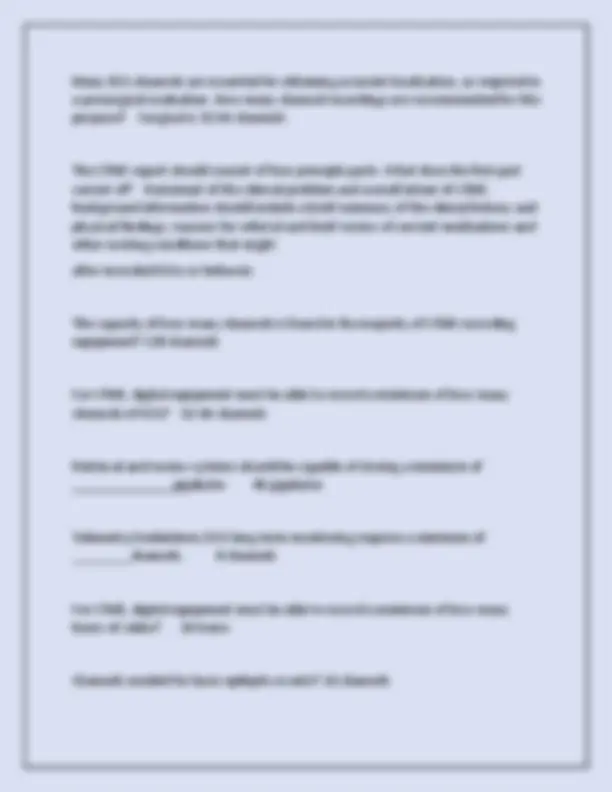
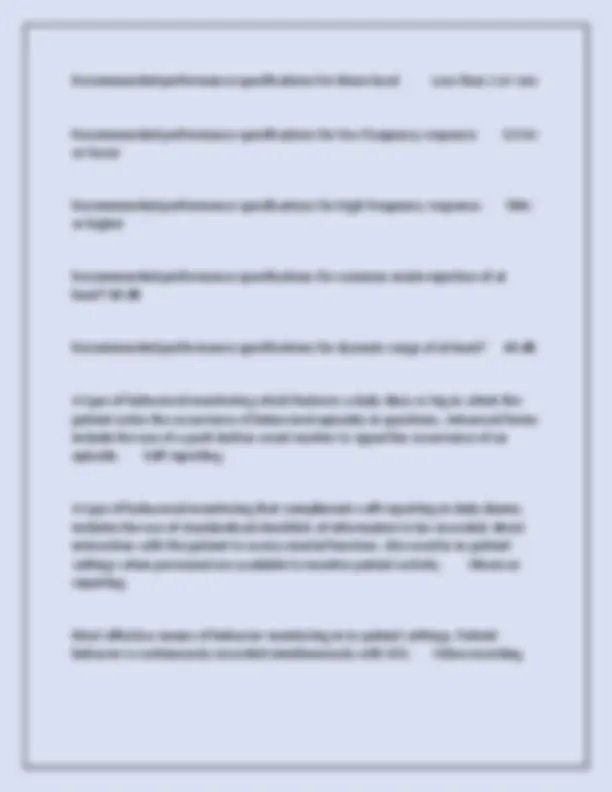
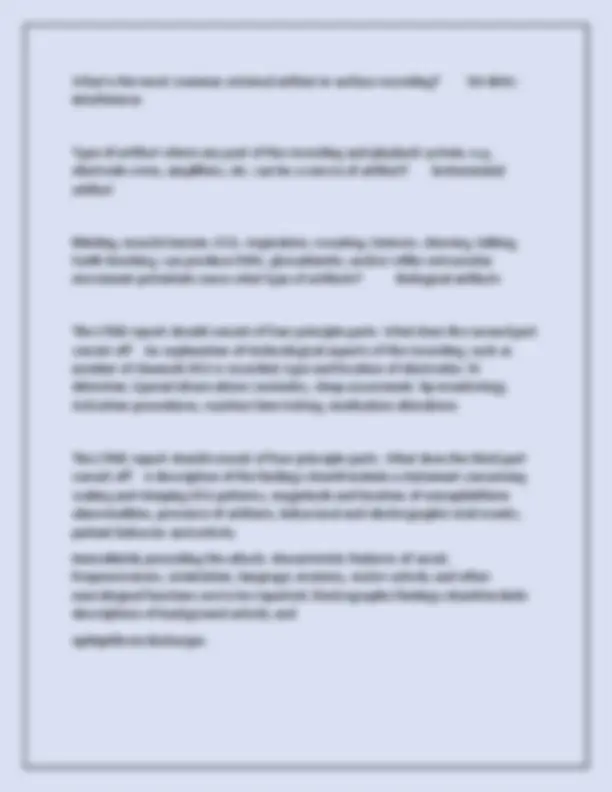
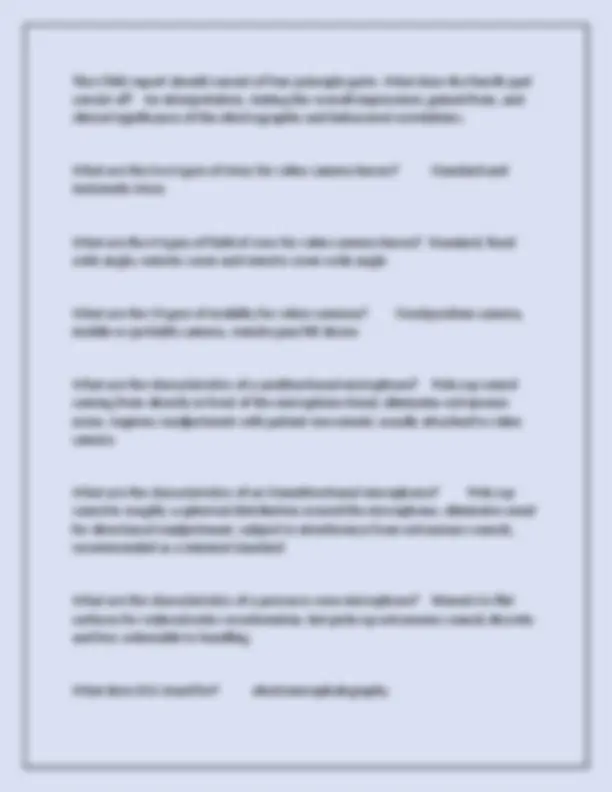
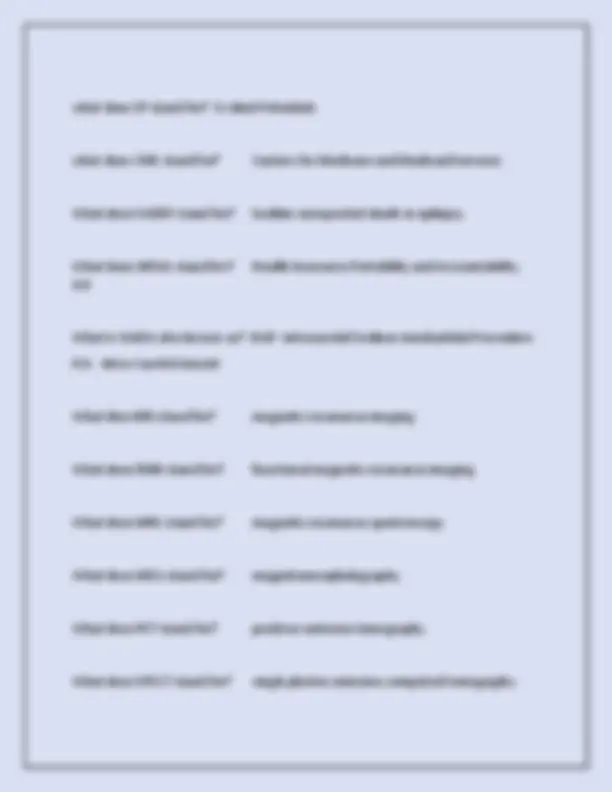
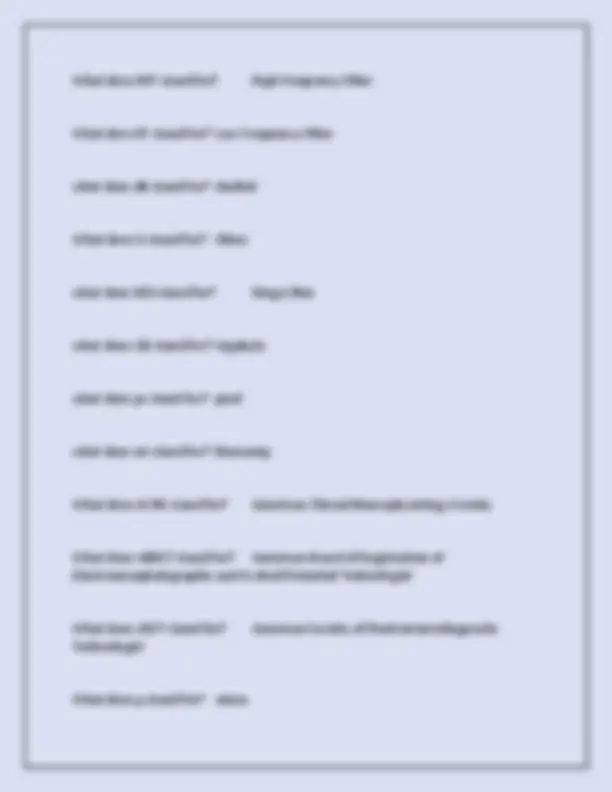
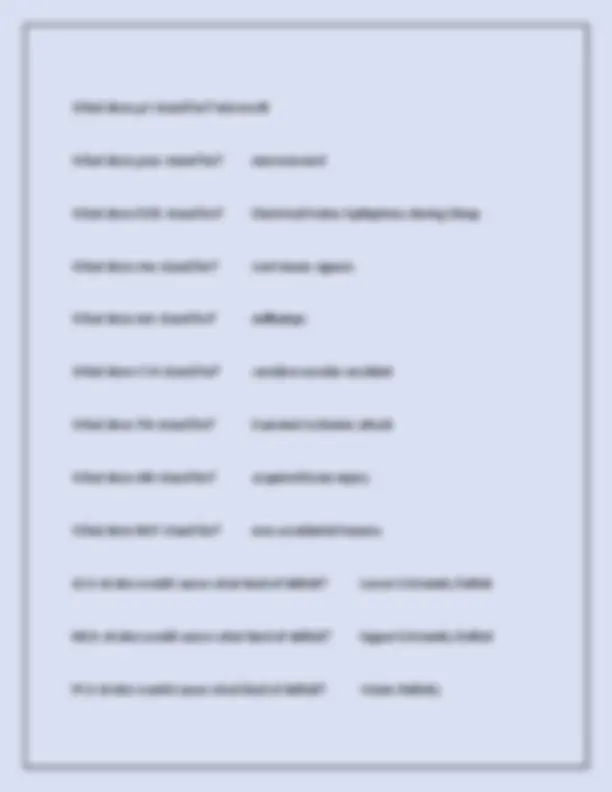
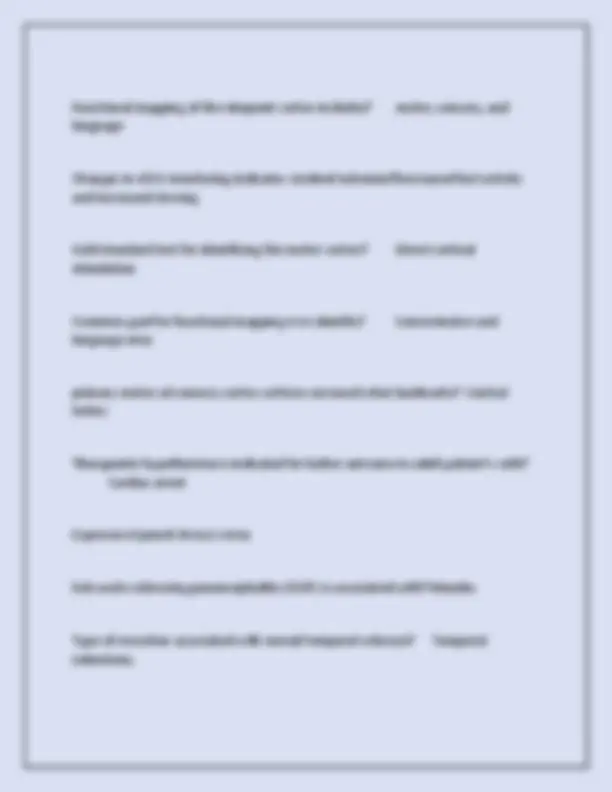
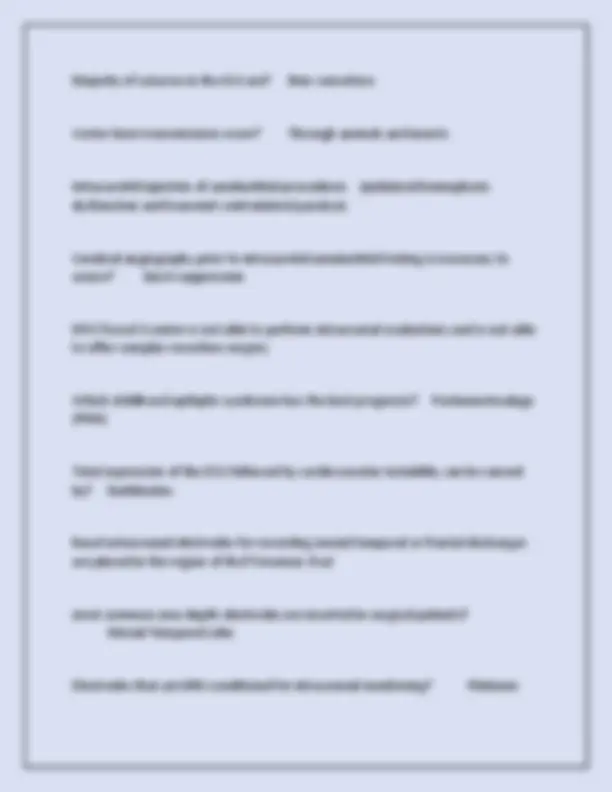
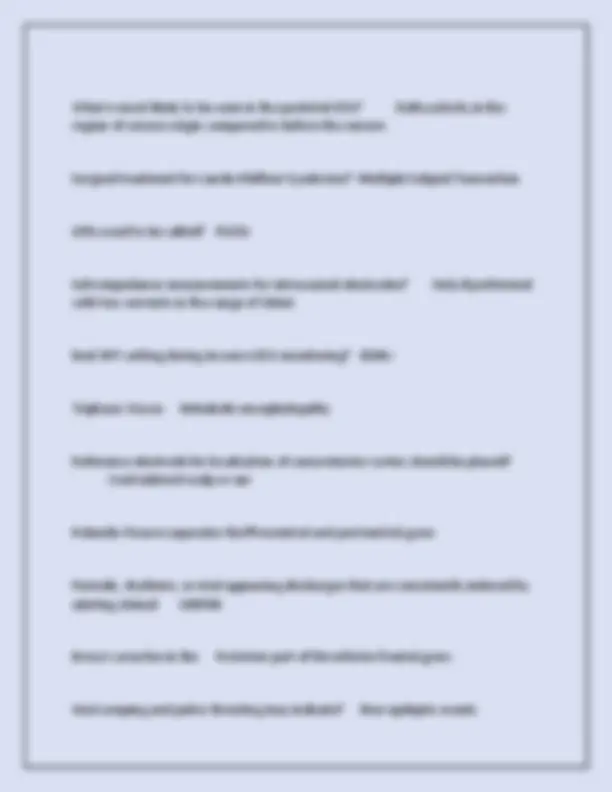
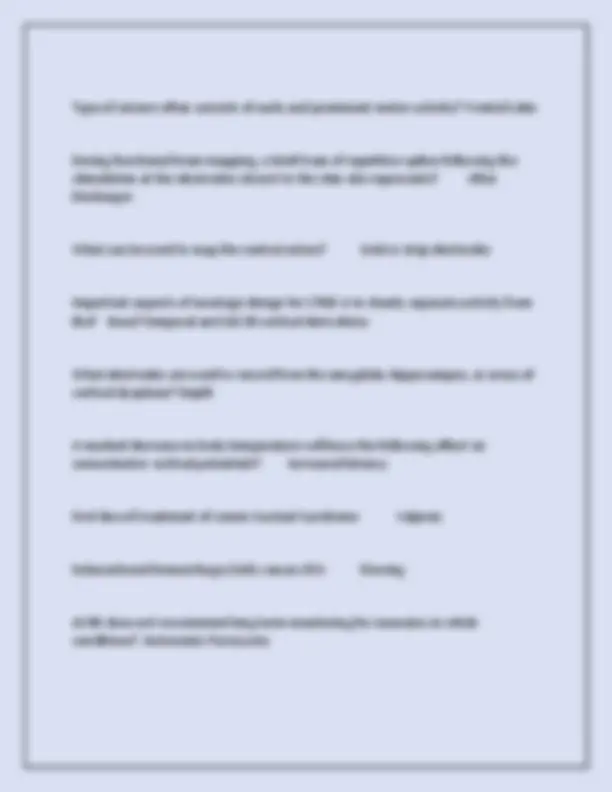
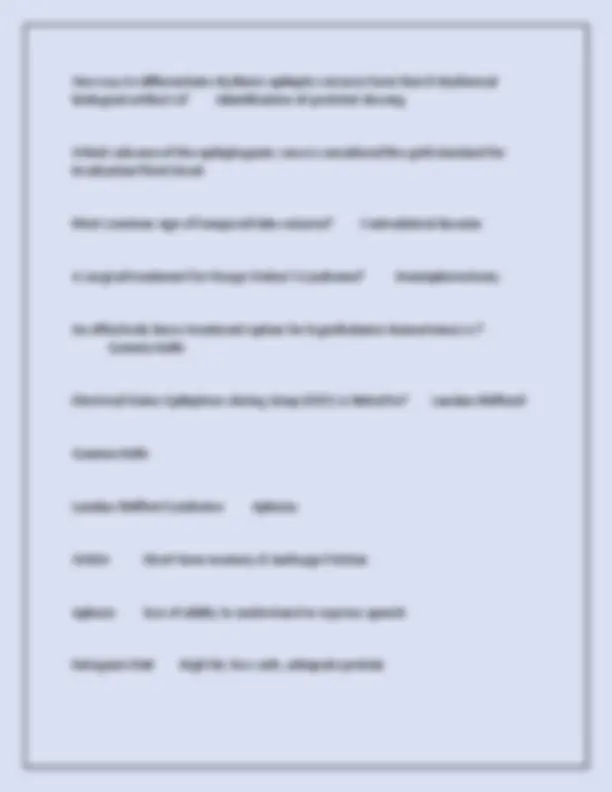
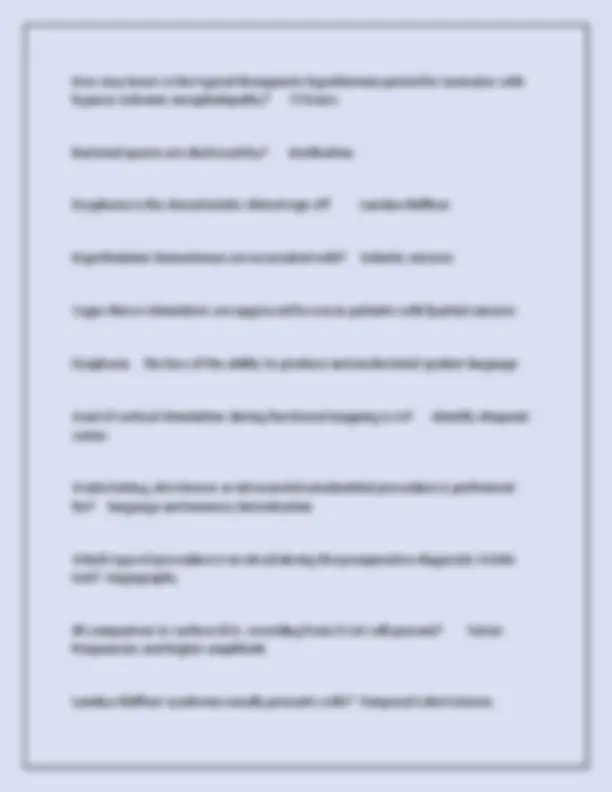
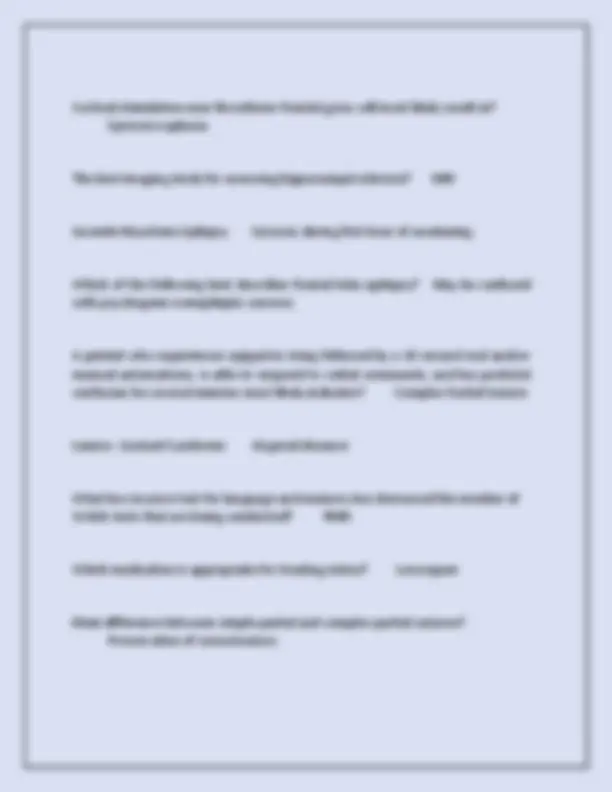
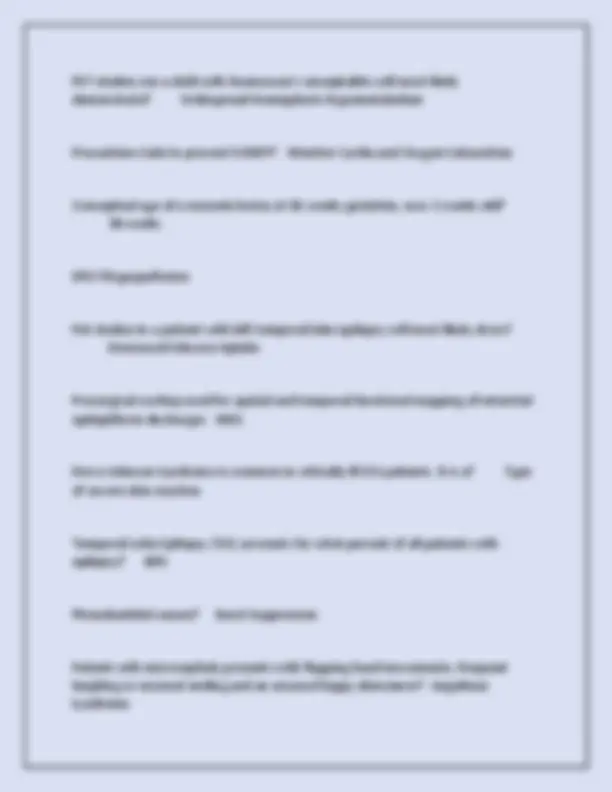
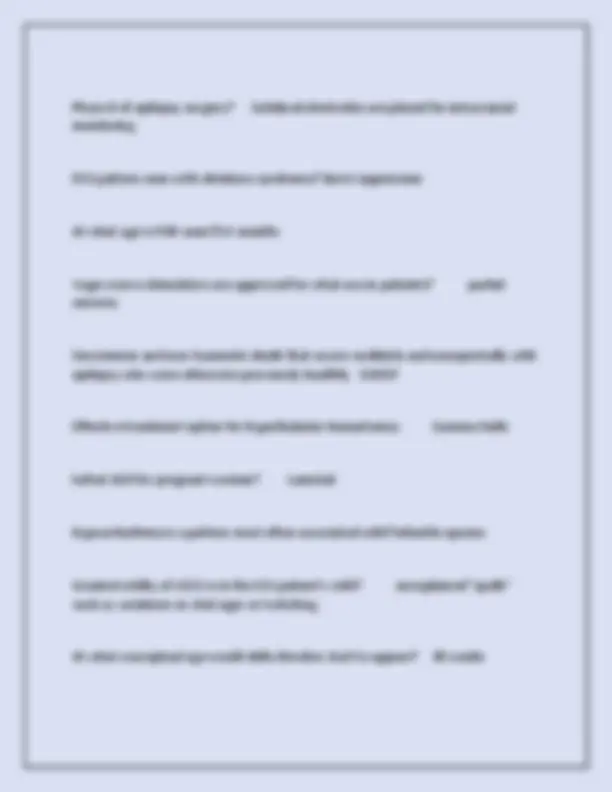
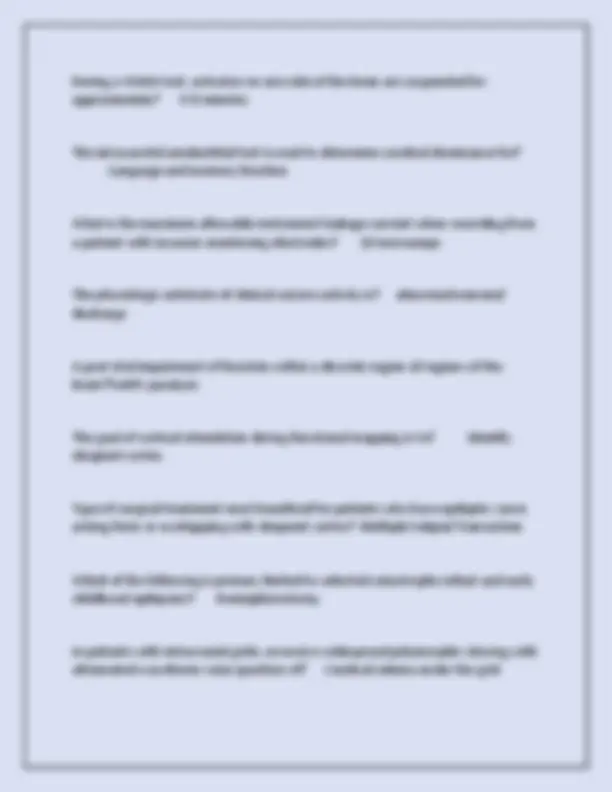
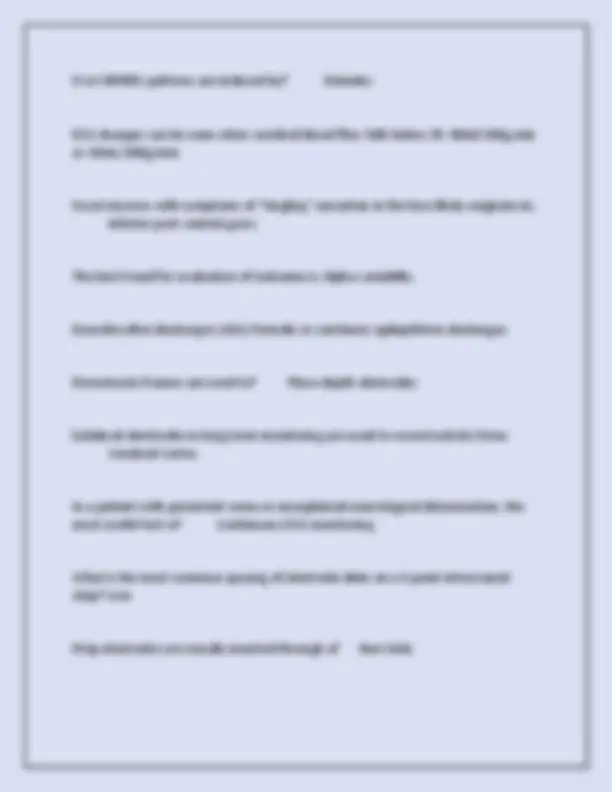
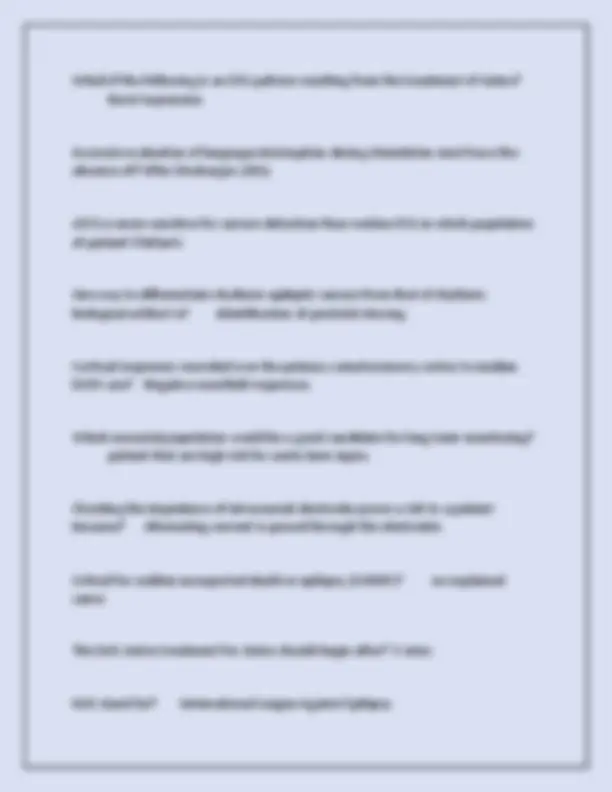
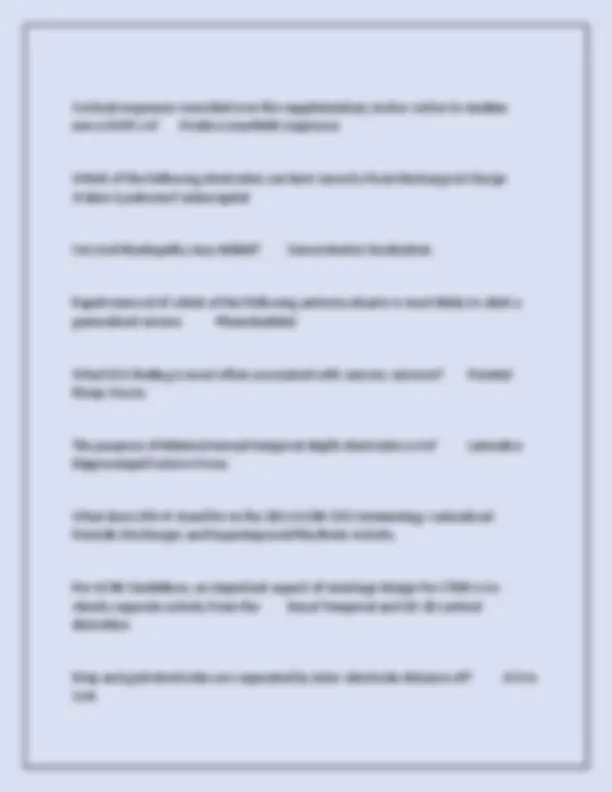
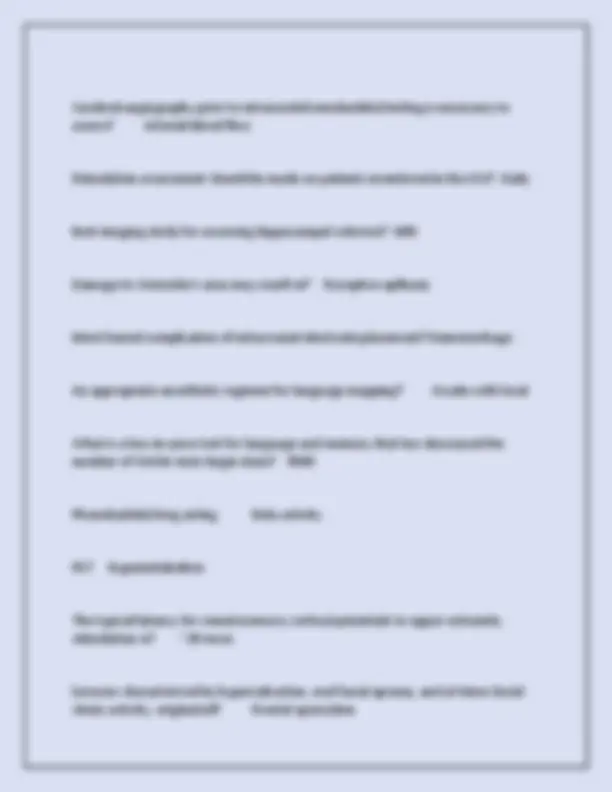
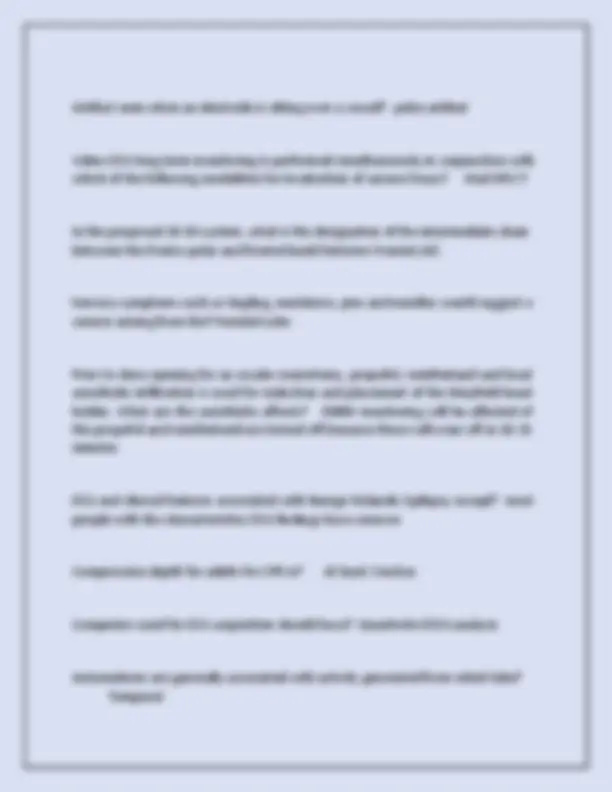
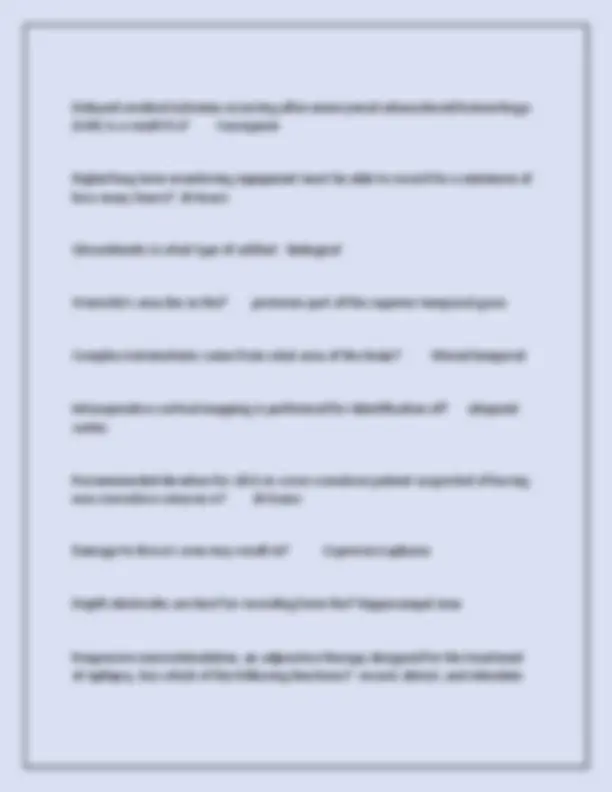
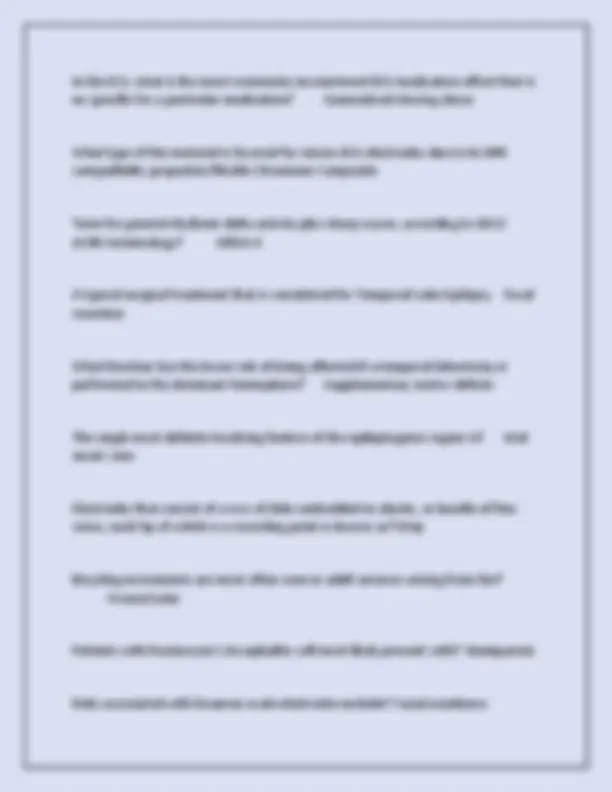
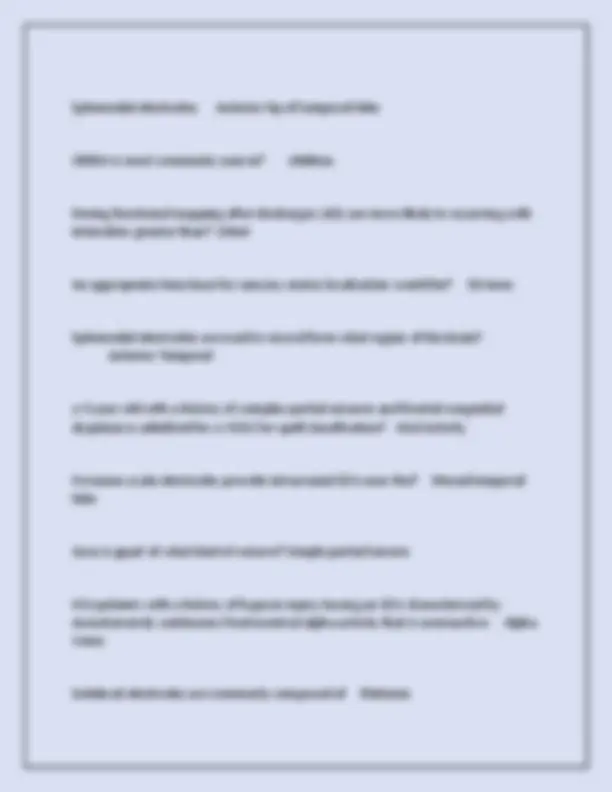
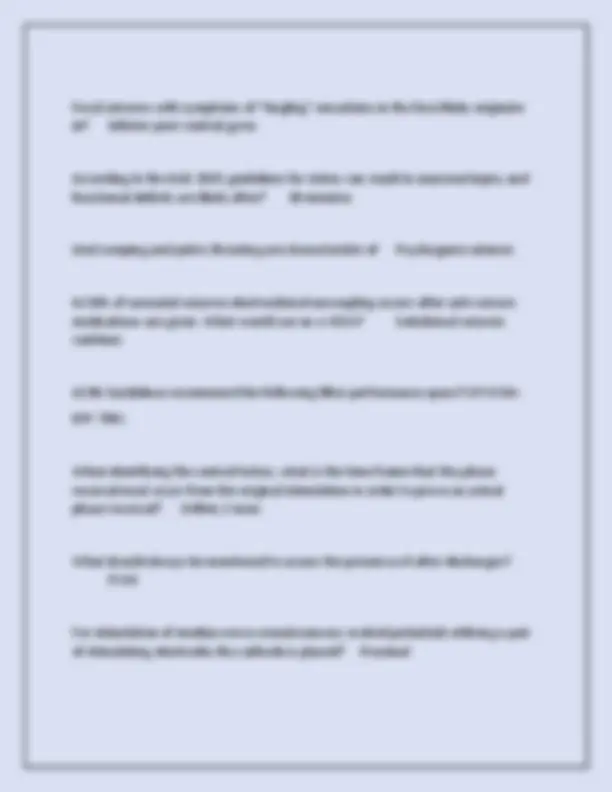
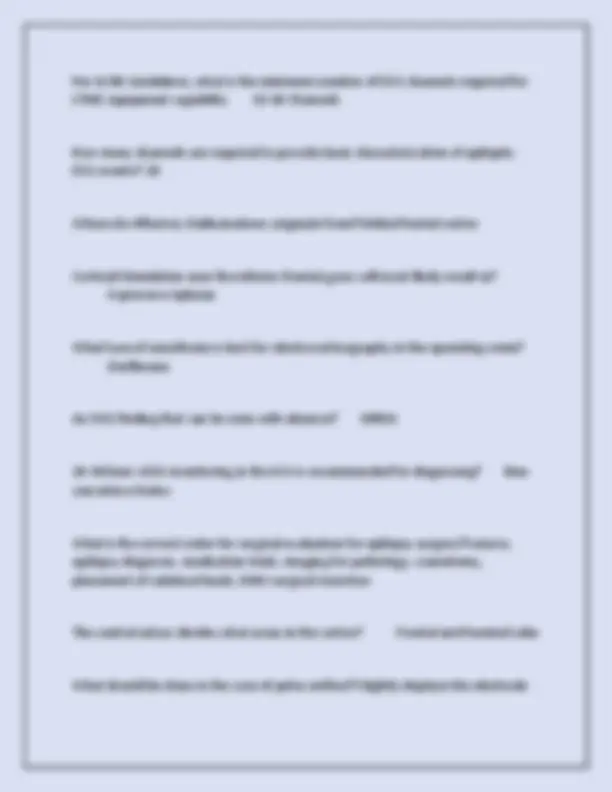
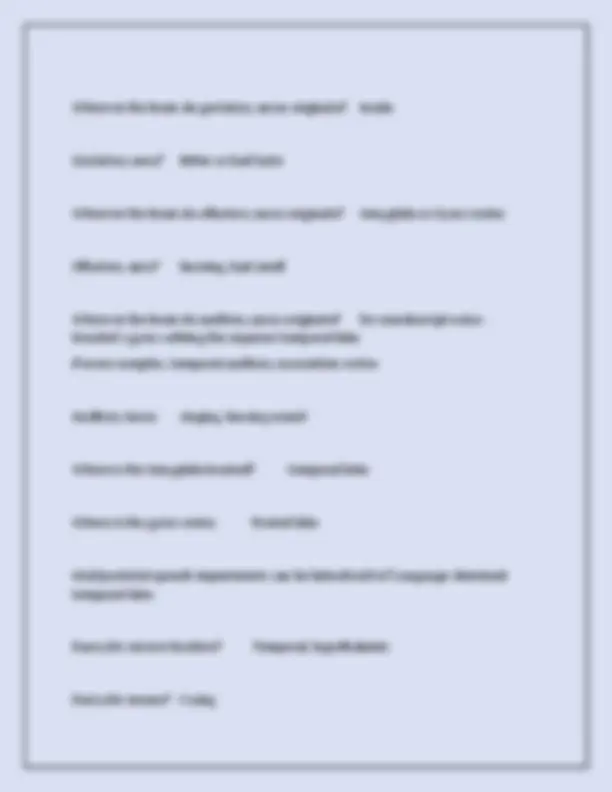
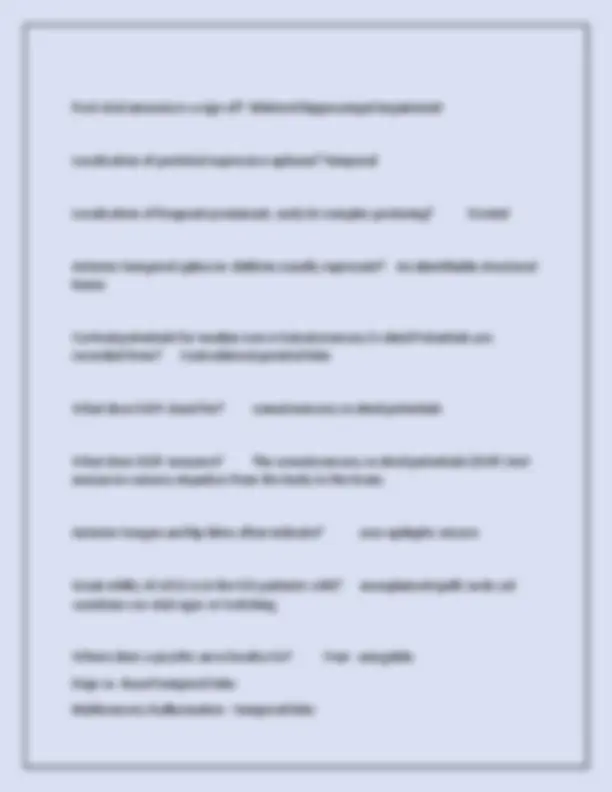
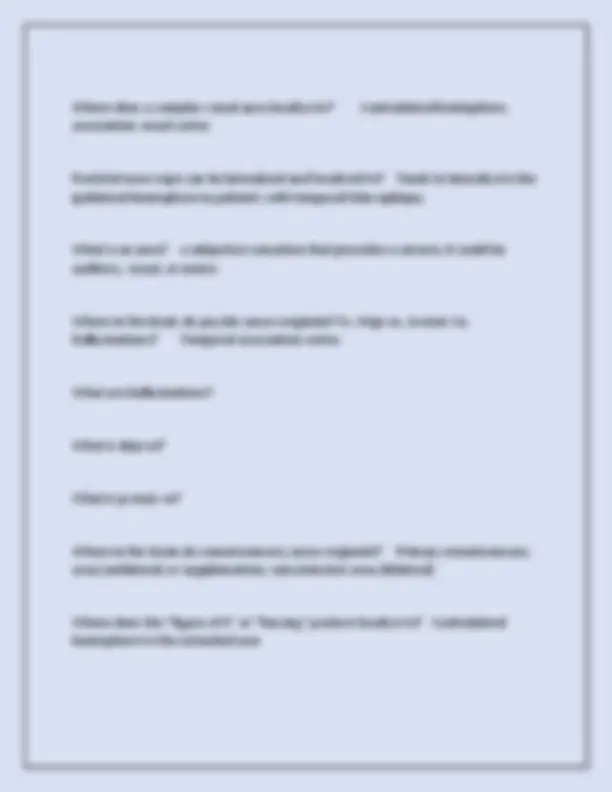
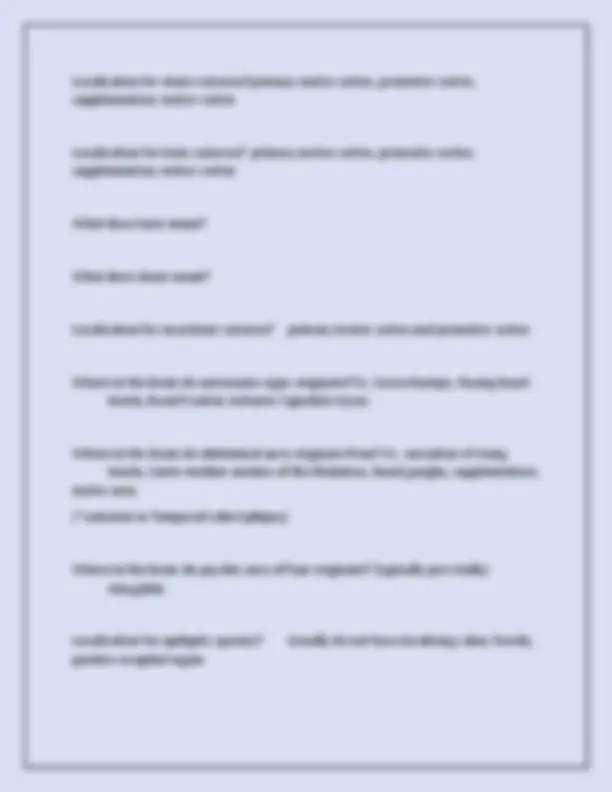
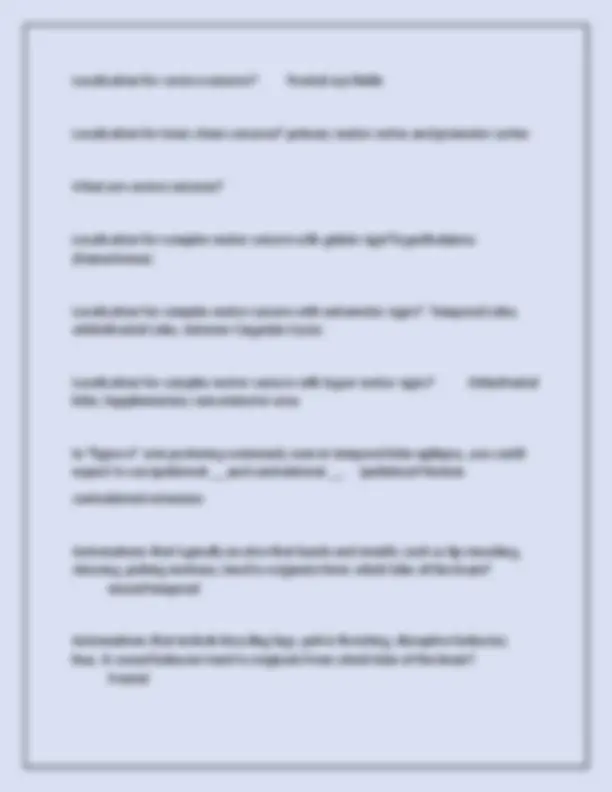


Study with the several resources on Docsity

Earn points by helping other students or get them with a premium plan


Prepare for your exams
Study with the several resources on Docsity

Earn points to download
Earn points by helping other students or get them with a premium plan
Community
Ask the community for help and clear up your study doubts
Discover the best universities in your country according to Docsity users
Free resources
Download our free guides on studying techniques, anxiety management strategies, and thesis advice from Docsity tutors
What are the characteristics of the sound mixer? Combines multiple audio sources into a single signal for recording on video Which of the following is typically associated with non-epileptic seizures: a. Episode lasting < (less than) two minutes b. Episode lasting > (greater than) two minutes c. Episode of tongue biting d. Episode of tongue thrusting Episode lasting > two minutes Define Hypergraphia An overwhelming urge to write. It is not itself a disorder, but can be associated with temporal lobe changes in epilepsy, and hypomania and mania in the context of bipolar disorder Which of the following is typically associated with non-epileptic seizures: a. Teeth breakage b. Severe tongue biting c. Bitting the inside of the mouth d. Bitting the tip of the tongue Biting the tip of the tongue
Typology: Exams
1 / 73

This page cannot be seen from the preview
Don't miss anything!


































































What are the characteristics of the sound mixer? Combines multiple audio sources into a single signal for recording on video Which of the following is typically associated with non-epileptic seizures: a. Episode lasting < (less than) two minutes b. Episode lasting > (greater than) two minutes c. Episode of tongue biting d. Episode of tongue thrusting Episode lasting > two minutes Define Hypergraphia An overwhelming urge to write. It is not itself a disorder, but can be associated with temporal lobe changes in epilepsy, and hypomania and mania in the context of bipolar disorder Which of the following is typically associated with non-epileptic seizures: a. Teeth breakage b. Severe tongue biting c. Bitting the inside of the mouth d. Bitting the tip of the tongue Biting the tip of the tongue
Which of the following is typically associated with non-epileptic seizures: a. Blinking b. Lip smacking c. Side to side head movements d. Eye deviation to the right Side to side head movements Which of the following is typically associated with non-epileptic seizures a. Bicycling actions of all limbs b. Pelvic thrusting & Weeping c. Picking or pulling at clothes d. Maturation Pelvic thrusting & weeping Which of the following is typically associated with non-epileptic seizures: a. Blinking b. Staring c. Eye deviation d. Eyes closed Eyes closed What does cEEG refer to? a. Cerebral b. Cortical c. Continous d. Coma Continous
c. MRN d. Date of Birth Room Number How often should critical care continuous EEG recording quality be checked? a. Impedances checked daily b. Electrode artifacts check twice daily c. patient skin daily d. reactivity daily e. all of the above All of the above What is the most sensitive tools for detecting cerebral ischemia and correlates with its location and degree? a. PET b. EEG c. fMRI d. SPECT fMRI What does OSHA stand for? Occupational Saftey & Health Administration OSHA function (select one) a. Prevents wrong-site surgery b. Protects Private Patient Health Information c. Insures an environment of patient safety d. insures and environment of safety for the staff insures an environment of safety for the staff
What does CMS stand for? Center for Medicare & Medicaid Services CMS administers: a. Medicare & Medicaid b. Medicare, Medicaid & HIPPA c. Affordable Care Act d. Joint commission Accreditation Medicare, Medicaid & HIPPA Define Dysgeusia Distortion of sense of taste. Used to describe seizure or aura with taste component. Define Dystonia Neurological movement disorder, in which sustained muscle contractions cause twisting and repetitive movements or abnormal postures. Define Ataxia Loss of the ability to coordinate muscular movement. Results in gait disturbance Define Caraplexy Sudden, transient episode of loss of muscle tone accompanied by full conscious awareness, often triggered by emotions such as laughing, crying, terror Define EEG in Caraplexy EEG is normal Define Narcolepsy Chronic neurological disorder caused by the brain's inability to regulate sleep-wake cycles normally
Define Cortical Dysplasia Cortical dysplasia is a congenital abnormality where the neurons is an area of the brains failed to migrate in the proper formation in utero. Occasionally neurons will develop that are larger than normal in certain areas. The causes the signals sent through the neurons in the area to misfire, which sends an incorrect signal. it is commonly found near the cerebral cortex and is associated with seizures. Cortical Dysplasia a. Absence Seizures b. Keppra c. Intractable Seizures d. West Syndrome Intractable Seizures Define Hyperlexia Seen in autism & Landau Kleffner A syndrome characterized by an intense fascination with letters or numbers and an advanced reading ability Define Hippocampal Sclerosis A neuropathological condition with severe neuronal cell loss and gliosis in the hippocampus, specifically in the CA- 1 (Cornu Ammonis Area 1) and subiculum of the hippocampus Which test detects Hippocampal Sclerosis? MRI Hippocampal Sclerosis a. Neocortex of Temporal Lobe b. Globaus Pallidues c. Mesial Temporal Lobe Epilepsy
d. Supplemental Motor Cortex Mesial Temporal Lobe Epilepsy Neocortex of Temporal Lobe a. Medial Temporal Lobe Epilepsy b. Lateral Temporal Lobe Epilepsy c. Mesial Temporal Lobe Epilepsy d. Longitudinal Temporal Lobe Epilepsy Lateral Temporal Lobe Epilepsy Brand/Trade name of Phenytoin Dilantin Brand/Trade name of Depakote Valproate Acid Side effect of abrupt Phenytoin withdrawal?Status Epilepticus Drug of choice for Infantile Spasms? ACTH Drug of choice for Juvenile Myoclonic Epilepsy? Depakote Drug of choice for Juvenile Absence seizures? (Brand and Generic Name) Brand - Zarontin Generic - Ethosuximide Drug of choice for Lennox-Gastaut? (Brand and Generic Name) Brand - Depakote
Clinical manifestations for Dacrystic Seizures Crying Most common co-morbidity in Gelastic & Dacrystic Seizures Hypothalamic Hamartoma Name this Seizure: Seizure begins with tingling sensation or motor movements in the fingers, then affects the hand and moves on to more proximal areas in the same side of the body with progression to the contralateral side of the body as the event rosses over the corpus callusom. Jacksonian Epilepsy or Jacksonian March Define Todd's Paralysis 1. Seizure followed by temporary paralysis
c. Infantile Spasms d. Tonic Clonic Seizures Infantile Spasms Hypsarrhythmia a. Lennox Gastaut b. Rasmussens Encephalitis c. Juvenile Myoclonic Epilepsy d. West Syndrome West Syndrome Abdominal Epilepsy (Stomach pain) a. Frontal Lobe b. Temporal Lobe c. Parietal Lobe d. Occipital Lobe Temporal Lobe Atonic Seizures a. Olfactory Aura b. Drop Attacks c. Infantile Seizures d. Epilepstic Syndrome Drop Attacks Atonic Seizures a. Affective Epilepsy b. Ataxic Epilepsy
a. Frontal Lobe b. Temporal Lobe c. Parietal Lobe d. Occipital Lobe Frontal Lobe (posterior frontal) Jacksonian March originating in left hand and fingers a. Onset in left temporal lobe (T3) b. Onset in right temporal lobe (T4) c. Onset in left frontal lobe (C3) d. Onset in right frontal lobe (C4) Onset in right frontal lobe (C4) Dysgeusia a. Memory b. Taste c. Déjà vu Smell Taste Seizure or aura involves dysgeusia a. Globus Pallidus b. Amydala c. Insula d. Hippocampus Insula Seizure or aura involves formed images or hallucinations
a. Globus Pallidus b. Amydala c. Insula d. Amygdala/Hippocampus Amygdala/Hippocampus Seizure or aura involves formed images or hallucinations a. Posterior Temporal Lobe b. Anterior Temporal Lobe c. Occipital Lobe d. Frontal Lobe Posterior Temporal Lobe Seizure or aura involves tingling sensation of right hand/arm a. anterior Parietal Lobe - Right b. Anterior Parietal Lobe - Left c. Posterior Frontal Lobe - Right d. Posterior Frontal Lobe - Left Anterior Parietal Lobe - Left Seizure or aura involves right eye deviation and head deviation with posturing a. Anterior Temporal Lobe - Left b. Anterior Parietal Lobe - Left c. Posterior Frontal Lobe - RIght d. Posterior Frontal Lobe - Left Posterior Frontal Lobe - Left Seizure or aura involves epigastric sensations and salivation
Age of onset (and peak age) for Benign Occipital Epilepsy15 month - 15 years Peak: 4-8 years Age of onset (and peak age) for Wests Syndrome < 1 year Peak: 3-7 months Age of onset (and peak age) for Lennox Gastaut 1 - 8 years Peak 3-5 years Age of onset for Landua-Kleffner 2 - 12 years Name the two epilepsy syndromes that have cognitive delay (mental retardation) as a characteristic West Syndrome & Lennox Gastaut Name the epilepsy syndrome that is characterized by speech arrest Landau- Kleffner Brian Stem Lesion: a. Spindles Coma b. Beta Coma c. Alpha Coma d. Theta Coma Alpha Coma Mesencephalic Lesion: a. Spindles Coma
Describe the reactivity of Alpha Coma Non-Reactive (EEG does not change with painful stimuli) Name the coma type which involves paralysis of the lower cranial nerves. Alpha COma Level of consciousness with Alpha Coma Alert & Awake Define Long-Term Porentiation A long-standing enhancement in signal transmission between two neurons that results from stimulating them synchronously. It is one of several phenomena underlying synaptic plasticity, the ability of chemical synapses to change their strength. As memories are through to be encoded by modification of synaptic strength, LTP is widely considered one of the major cellular mechanisms that underlies learning and memory Hippocampus a. Limbic System b. Reticular Formation c. Lymphatic System d. Cortical System Limbic System What are the four Hippocampus functions? 1. Short Term Memory
Long Term Potentiation a. Neural Matric b. Neural Tissue c. Neural Network d. Neural Plasticity Neural Plasticity Define Neural Plasticity Refers to changes in neural pathways and synapses which are due to changes in behavior, environment and neural processes, as well as changes resulting from bodily injury What are the two Parahippocampal Gyrus functions? 1. Memory Encoding